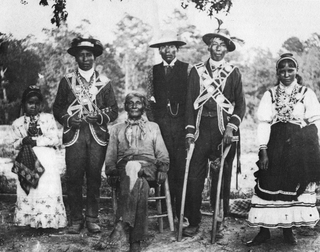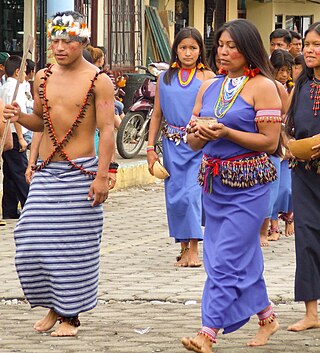Related Research Articles

Choctaw mythology is part of the culture of the Choctaw, a Native American tribe originally occupying a large territory in the present-day Southeastern United States: much of the states of Mississippi, Alabama, and Louisiana. In the 19th century, the Choctaw were known to European Americans as one of the "Five Civilized Tribes" even though controversy surrounds their removal.

Korean mythology is the group of myths told by historical and modern Koreans. There are two types: the written, literary mythology in traditional histories, mostly about the founding monarchs of various historical kingdoms, and the much larger and more diverse oral mythology, mostly narratives sung by shamans or priestesses (mansin) in rituals invoking the gods and which are still considered sacred today.

A shrunken head is a severed and specially-prepared human head – often decreased to many times smaller than typical size – that is used for trophy, ritual, trade, or other purposes.

The Shuar, also known as Jivaro, are an indigenous ethnic group that inhabits the Ecuadorian and Peruvian Amazonia. They are famous for their hunting skills and their tradition of head shrinking, known as Tzantsa.

The Inuit angakkuq is an intellectual and spiritual figure in Inuit culture who corresponds to a medicine man. Other cultures, including Alaska Natives, have traditionally had similar spiritual mediators, although the Alaska Native religion has many forms and variants.

The Achuar are an Indigenous people of the Americas belonging to the Jivaroan family, alongside the Shuar, Shiwiar, Awajun, and Wampis (Perú). They are settled along the banks of the Pastaza River, Huasaga River, and on the borders between Ecuador and Perú. The word "Achuar" originates from the name of the large palm trees called "Achu" that are abundant in the swamps within their territory.
Kaúxuma Núpika, also known as Qánqon Kámek Klaúla or Manlike Woman, was a Kutenai person who lived in the early 19th century.
The gender of God can be viewed as a literal or as an allegorical aspect of a deity.

Melanesian mythology refers to the folklore, myths, and religions of Melanesia, a region in Southwest Oceania that encompasses the archipelagos of New Guinea, the Torres Strait Islands, Solomon Islands, Vanuatu, New Caledonia and Fiji. The various mythologies consist primarily of the traditions of oral literature in the different populations of Melanesia. More recent aspects include the cargo cults born in the 20th century during the Pacific War.

Eunectes is a genus of boas found in tropical South America commonly called anacondas. They are a semiaquatic group of snakes and include one of the largest snakes in the world, E. murinus, the green anaconda. Four species are currently recognized.

The Jivaroan peoples are the indigenous peoples in the headwaters of the Marañon River and its tributaries, in northern Peru and eastern Ecuador. The tribes speak the Chicham languages.

LGBT themes in mythology occur in mythologies and religious narratives that include stories of romantic affection or sexuality between figures of the same sex or that feature divine actions that result in changes in gender. These myths are considered by some modern queer scholars to be forms of lesbian, gay, bisexual, or transgender (LGBT) expression, and modern conceptions of sexuality and gender have been retroactively applied to them. Many mythologies ascribe homosexuality and gender fluidity in humans to the action of gods or of other supernatural interventions.

Gut are the rites performed by Korean shamans, involving offerings and sacrifices to gods, spirits and ancestors. They are characterised by rhythmic movements, songs, oracles and prayers. These rites are meant to create welfare, promoting commitment between the spirits and humankind. The major categories of rites are the naerim-gut, the dodang-gut and the ssitgim-gut.
The spirit spouse is a widespread element of shamanism, distributed through all continents and at all cultural levels. Often, these spirit husbands/wives are seen as the primary helping spirits of the shaman, who assist them in their work, and help them gain power in the world of spirit. The relationships shamans have with their spirit spouses may be expressed in romantic, sexual, or purely symbolic ways, and may include gender transformation as a part of correctly pairing with their "spouse". Shamans report engaging with their spirit spouses through dreams, trance, and other ritual elements. In some cultures, gaining a spirit spouse is a necessary and expected part of initiation into becoming a shaman. Examples of spirit spouses may be seen in non-shamanic cultures as well, including dreams about Jesus Christ by nuns, who are considered to be "brides of Christ".
Vegetalismo is a term used to refer to a practice of mestizo shamanism in the Peruvian Amazon in which the shamans—known as vegetalistas—are said to gain their knowledge and power to cure from the vegetales, or plants of the region. Many believe to receive their knowledge from ingesting the hallucinogenic, emetic brew ayahuasca.

Tsentsak are invisible pathogenic projectiles or magical darts utilized in indigenous and mestizo shamanic practices for the purposes of sorcery and healing throughout much the Amazon Basin. Anthropologists identify them as objects referenced in emic accounts that represent indigenous beliefs. Tsentak are not recognized in scientific medicine.
The Yacuruna are a mythical water people of the Amazon basin who live in beautiful underwater cities, often at the mouths of rivers. Belief in the Yacuruna is most prominently found among indigenous people of the Amazon. The term is derived from the Quechua language, yaku ("water") and runa ("man").

Mu (Korean: 무) is the Korean term for a shaman in Korean shamanism. Korean shamans hold rituals called gut for the welfare of the individuals and the society.
Norman E. Whitten, Jr. is an American cultural anthropologist who is Professor Emeritus of Anthropology and Latin American Studies at the University of Illinois Urbana-Champaign, and Curator of the Spurlock Museum of World Cultures. He is known for books based on his anthropological field work and his research on the Afro-Latin and Indigenous peoples of the West Coast rainforest and upper Amazon Rain forest, most notably the Black population and Canelos Quichua and Achuar Peoples.
References
- Beyer, Stephen V. (2009). Singing to the Plants: A Guide to Mestizo Shamanism in the Upper Amazon. University of New Mexico Press. p. 530. ISBN 978-0-8263-4730-5.
- Brown, M.F. (1988). "Shamanism and Its Discontents". Medical Anthropology Quarterly. 2 (2): 102–120. doi:10.1525/maq.1988.2.2.02a00020.
- Perruchon, Marie (2003). I am Tsunki: Gender and Shamanism among the Shuar of Western Amazonia. Uppsala: Acta Universitatis Upsaliensis. p. 402. ISBN 91-554-5646-4.
- Whitten, Norman E.; Dorothea Scott Whitten (2008). Puyo Runa: Imagery and Power in Modern Amazonia. Urbana and Chicago: University of Illinois Press. p. 304. ISBN 978-0-252-07479-0.